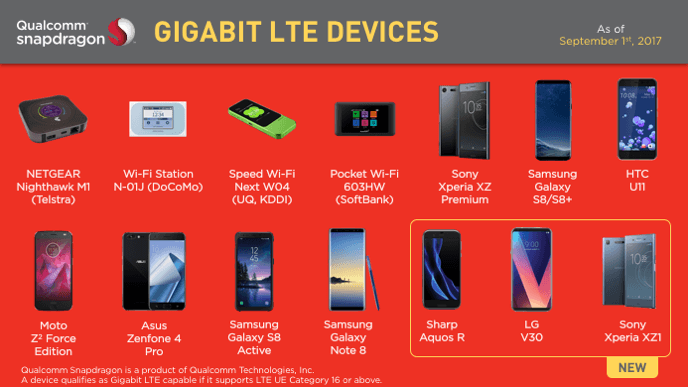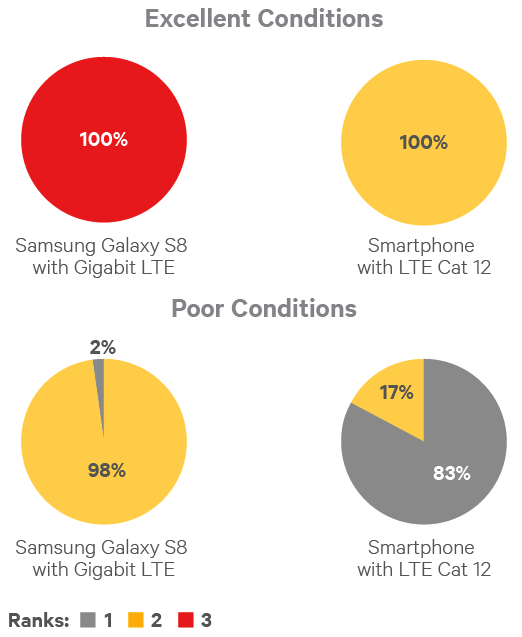Momentum for Gigabit LTE continues to improve as more operators and device makers get on board. A recent third-party study underscores the benefits of the new technology to both end users and operators that are driving this shift. The testing showed surprising gain in real-world use cases such as downloading a mobile game or other large file and streaming high-quality video. The study also shows how improvements in network efficiency help not only the person using a Gigabit LTE phone but also other nearby phone users.
At least 43 operators in 25 countries are planning, trialing, or deploying Gigabit LTE. Device makers now offer a total of 16 devices that support Gigabit LTE, including 10 phones. All of these phones are Android models, including the LG V30, Moto Z2 Force Edition, and Samsung Galaxy S8, S8+, and Note 8. In contrast, Apple’s newest phones, including the iPhone 8 and flagship iPhone X, are limited to LTE Category 12 (600Mbps peak). That company prefers to dual-source its modem chips from Intel and Qualcomm, and while Qualcomm supports Gigabit LTE, Intel’s available modem chips are limited to Cat12, although that vendor is working on its own gigabit chip.
Some people may think that 600Mbps is more than halfway to 1 Gbps, so what’s the difference? Qualcomm recently commissioned Signals Research Group (SRG), a well-respected wireless-benchmarking firm, to find out. The tests compared a Galaxy S8 phone, capable of Gigabit LTE operation, against a “generic” smartphone using a Cat12 modem. This less-advanced phone represents the LTE capabilities of Cat12 devices from Apple and others.
In the first test, SRG used each phone to download a 350MB mobile game from the Google Play Store as well as a 2GB file from Google Drive. Under excellent reception conditions, the Gigabit LTE phone enters 4×4 MIMO mode, gaining an extra set of data streams to speed the download. As a result, it took 15–20% less time than the Cat12 phone to complete the downloads. This gain is less than the actual increase in data rate, as it includes overhead to start and complete the interaction, but still significant.
In poor conditions, representing what might happen when a user is far from the base station, the signal is too weak for 4×4 MIMO to work, so one might expect both phones to have the same performance. Using its four antennas, however, the Galaxy S8 can still achieve 2×2 MIMO most of the time, as the figure shows. A Cat12 phone, in contrast, has only two antennas and falls back to a single stream (rank) 83% of the time, according to the SRG testing. As a result, the Gigabit LTE phone has a surprising 23–27% advantage in download time even with poor reception.
You might not mind waiting a bit longer for your download, but this advantage becomes more prominent when watching video. SRG found that when streaming a 15Mbps video under poor conditions, the Cat12 phone had 50% more freezes, twice as many video impairments, and more than three times as many audio/video synchronization problems. Thus, a Gigabit LTE phone can deliver better video even with poor reception.
The tests also measured network resource usage, a factor important to operators. Each cell site has a limited number of frequencies (bands) available and must allocate them among all users, so the sooner one device finishes, the more bands are available for others. In SRG’s tests, the Galaxy S8 used 33–43% fewer resources than the Cat12 phone. In a live demo, T-Mobile measured the download speed of a group of Cat12 phones, then showed that replacing half of the phones with Gigabit LTE models actually increased the download speed on the Cat12 phones by 23%. In other words, a single Gigabit LTE phone can improve the performance of all the other phones connected to the same base station.
Cellular operators are moving to Gigabit LTE to improve the capacity and quality of their networks. Phone makers are adding Gigabit LTE modems to take advantage of these new capabilities and deliver improved experiences to their customers. Even when these networks began the transition to 5G in 2019 and beyond, Gigabit LTE will play an important role, delivering high-speed communication where 5G signals are unavailable. Thus, these new devices will help operators and end users both today and well into the 5G future.
Development of this article is funded by Qualcomm, but all opinions are the author’s.


